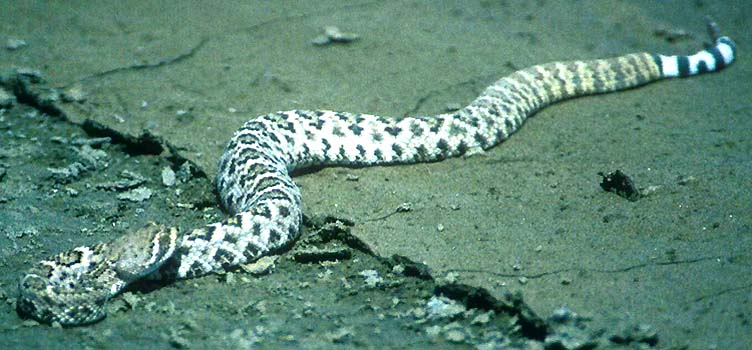I have yet to see Red Diamondback or Mojave Rattlesnake in the state;
it is interesting that Mojave is the rattler that has developed venom that
is drop-for-drop some ten times more potent that ordinary rattlesnake venom.
These and a wide host of interesting facts about rattlesnakes are found
in the classic awork by Klauber (1972; this is the popularized, abridged
version of his earlier multi-volume books). In researching this page, I
also found the summaries and great photos in Mattison (1996) to be very
helpful. That book not only has color photos of all U.S. species, but all
the Neotropical species as well.
Ashton, K.G. & A. de Queiroz. 2001. Molecular Systematics
of the western rattlesnake, Crotalus viridis (Viperidae), with comments
on the utility of the D-Loop in phylogenetic studies of snakes. Molecular
Phylogenetics & Evolution 21:176-189.
Crother, B.I., chair. 2001. Scientific and standard English names of
amphibians and reptiles of North America north of Mexico, with comments
regarding confidence in our understanding. Committee of Standard English
and Scientific Names, Society for the Study of Amphibians and Reptiles,
Herpetological Circular 29 (as supplemented in Herp. Review 32: 152-153).
Douglas, M. E., M.R. Douglas, G.W. Schuett, L.W. Porras & A.T. Holycross.
2002. Phylogeography of the western rattlesnake (Crotalus viridis) complex,
with emphasis on the Colorado Plateau, pp. 11-50 in G.W. Schuett,
M. Höggren, M. E. Douglas and H. W. Greene (eds.), Biology of the
Vipers. Eagle Mountain Publ., Eagle Mountain, UT.
Klauber, L.M. 1972. Rattlesnakes: Their Habits, Life Histories, and
Influence on Mankind. Abridged ed. by K.H. McClung. Univ. of Calif. Press,
Berkeley. Publ. for Zoological Soc., San Diego.
Mattison, C. 1996. Rattler! A Natural History of Rattlesnakes. Blandford,
London.
Pook, C.E., W. Wüster & R.S. Thorpe. 2000. Historical biogeography
of the western rattlesnake (Serpentes: Viperidae: Crotalus viridis),
inferred from mitochondrial DNA sequence information. Molecular Phylogenetics
& Evolution 15: 269-282.
Stebbins, R.C. 1966. A Field Guide to Western Reptiles and Amphibians.
Houghton Mifflin, Boston.
Stebbins, R.C. 1985. A Field Guide to Western Reptiles and Amphibians.
2d ed. Houghton Mifflin, Boston.
Stebbins, R.C. 2003. A Field Guide to Western Reptiles and Amphibians.
3d ed. Houghton Mifflin, Boston.
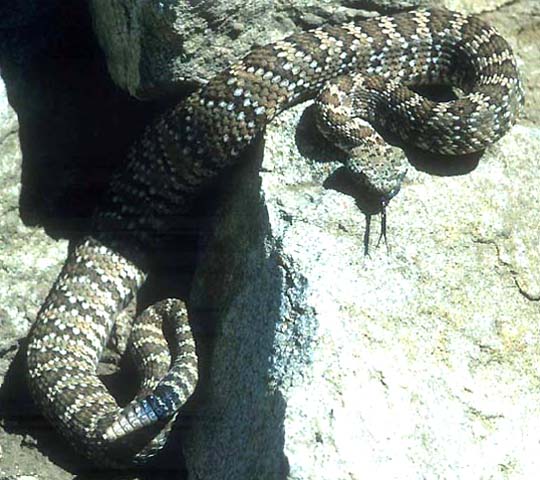
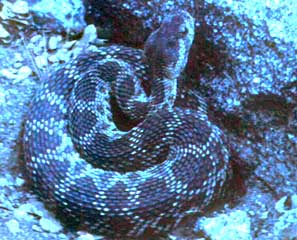
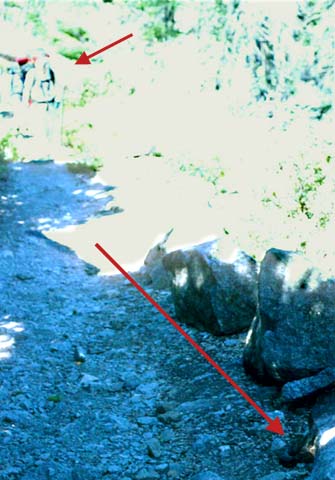

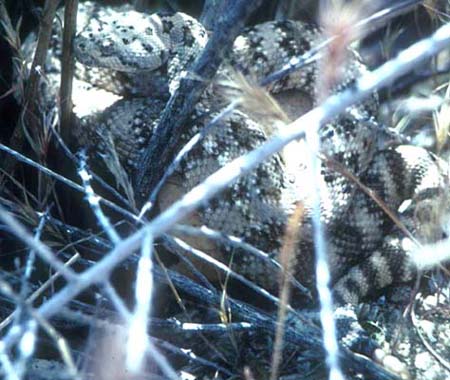 I
mentioned the problems I have had in the past trying to identify rattlesnakes
in California. Because the colors of rattlesnakes can be so variably, depending
on their habitat, Stebbins (1966, 1985, 2003) emphasizes scalation patterns
that are damned near impossible to see in live snakes in the field, and
hard to work with even in less-than-crystal-clear photos (i.e., in other
words, my photos). Under I started putting together this page, and John
Sullivan gently put me straight, I had misidentified and mislabeled the
snakes shown above and right. They are, in fact, both different races of
Speckled
Rattlesnake C. mitchellii [as is the headline species at top
of the page, also misidentified in the field]. Above is the beautiful
Panamint
Rattlesnake C. m. stephensi [photo May 1988 Willow Wash, Inyo
Co.]; to the right is the much paler and less patterned Southwestern
Speckled Rattlesnake C. m. pyrrhus [photo May 1985 Morongo Valley,
San Bernardino Co.].
I
mentioned the problems I have had in the past trying to identify rattlesnakes
in California. Because the colors of rattlesnakes can be so variably, depending
on their habitat, Stebbins (1966, 1985, 2003) emphasizes scalation patterns
that are damned near impossible to see in live snakes in the field, and
hard to work with even in less-than-crystal-clear photos (i.e., in other
words, my photos). Under I started putting together this page, and John
Sullivan gently put me straight, I had misidentified and mislabeled the
snakes shown above and right. They are, in fact, both different races of
Speckled
Rattlesnake C. mitchellii [as is the headline species at top
of the page, also misidentified in the field]. Above is the beautiful
Panamint
Rattlesnake C. m. stephensi [photo May 1988 Willow Wash, Inyo
Co.]; to the right is the much paler and less patterned Southwestern
Speckled Rattlesnake C. m. pyrrhus [photo May 1985 Morongo Valley,
San Bernardino Co.].
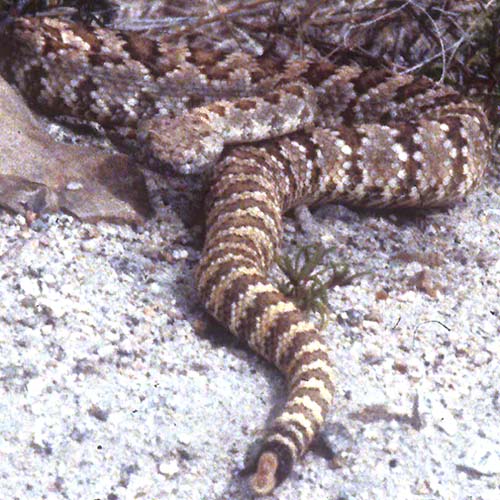 To the left is another photo of the same Panamint Rattler
shown stretched out above. One thing I notice in this shot — and in every
other photo of Speckled Rattlesnake on this page and elsewhere on the web
— is that Speckled Rattlesnake has a really flat and triangular shaped
head. Compare that head shape with the little Northern Pacific Rattlesnake
(below) from Tulare County. The head of Western may be triangular but it
is thick and jowly. I've noted this on a lot of other on-line photos also.
Stebbins' field guides don't mention these shape difference but there is
a very different jizz — a concept birders will recognize — to the heads
of these, and presumably other, rattlesnakes. This character needs more
work but might prove useful
To the left is another photo of the same Panamint Rattler
shown stretched out above. One thing I notice in this shot — and in every
other photo of Speckled Rattlesnake on this page and elsewhere on the web
— is that Speckled Rattlesnake has a really flat and triangular shaped
head. Compare that head shape with the little Northern Pacific Rattlesnake
(below) from Tulare County. The head of Western may be triangular but it
is thick and jowly. I've noted this on a lot of other on-line photos also.
Stebbins' field guides don't mention these shape difference but there is
a very different jizz — a concept birders will recognize — to the heads
of these, and presumably other, rattlesnakes. This character needs more
work but might prove useful
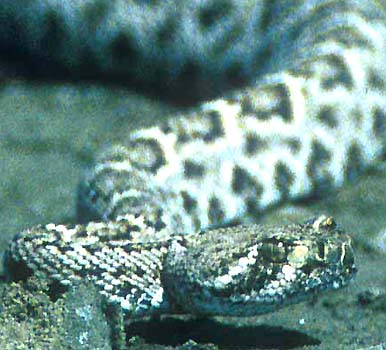 One
rattler that I have found easy to identify in southeastern California is
Western
Diamondback Rattlesnake [right and below, photos May
1998 near north end Salton Sea, Riverside Co.]. Its a BIG, thick-bodied,
broad-headed rattler with conspicuous black-and-white rings before the
rattle. I've read some surveys (e.g., Klauber 1972) that found the species
to the the commonest snake (not just rattlesnake!) is some parts of southern
Arizona (e.g., Organ Pipe Cactus NM). It is said to be an aggressive snake
but, despite the look of the photo to the right, I've always kept a fair
distance!
One
rattler that I have found easy to identify in southeastern California is
Western
Diamondback Rattlesnake [right and below, photos May
1998 near north end Salton Sea, Riverside Co.]. Its a BIG, thick-bodied,
broad-headed rattler with conspicuous black-and-white rings before the
rattle. I've read some surveys (e.g., Klauber 1972) that found the species
to the the commonest snake (not just rattlesnake!) is some parts of southern
Arizona (e.g., Organ Pipe Cactus NM). It is said to be an aggressive snake
but, despite the look of the photo to the right, I've always kept a fair
distance!